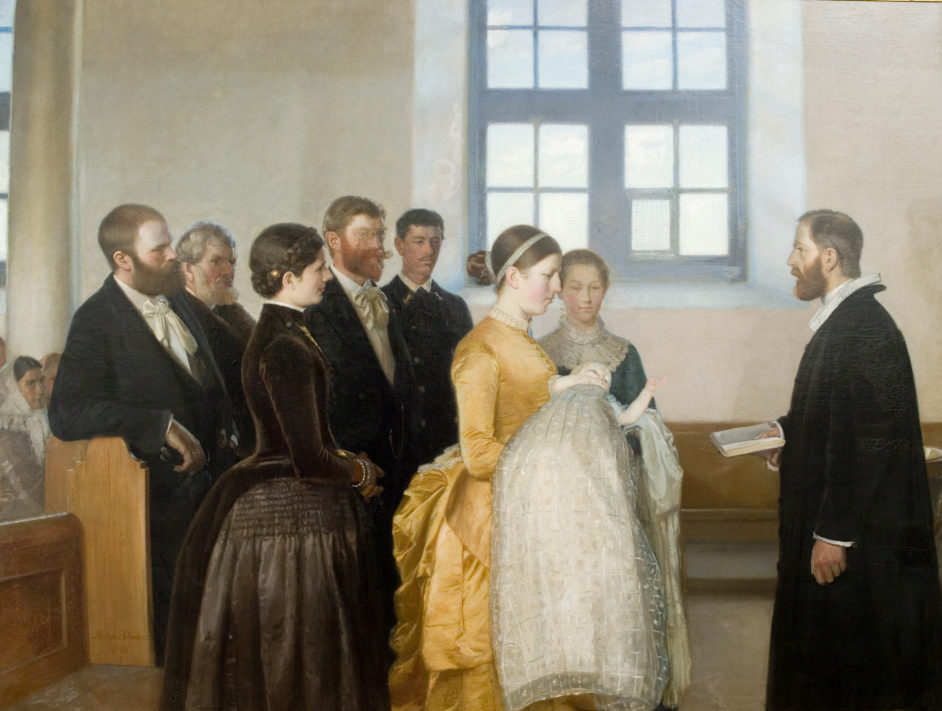
Michael Ancher (1849-1927)
A Christening. 1883-1888
- 186 x 250 cm
- RKMm0006
- Artworks on display
The collection at Ribe Kunstmuseum includes a painting whose vast size, 186 x 250 cm, stops most people in their tracks and forces them to look. The subject matter is clearly legible: a group of people in a church. A woman, dressed in yellow, acts as the main focal point. She holds an infant in her arms. Light falls from a church window down upon the woman and child, giving them a prominent position – there can be no doubt about who is the main focus here. The group is standing along the white walls of Skagen Church. Behind the woman is a number of figures dressed in darker colours; in front of her is the priest. The infant reaches out for him. The painting depicts the baptism of Michael and Anna Ancher’s daughter, Helga. The woman in the yellow dress is Anna, and behind her we see the painter P.S. Krøyer, Anna’s brother John (Johan Henrik) Brøndum and the English painter Marianne Stokes. To the far left is Michael Ancher himself and a man from the town, known as Mr Mariager, who was frequently used as a model by Anna and Michael Ancher.
The creative process – a long, hard pull
On paper, it took Ancher five years to create A Christening, but in actual fact he reworked the piece numerous times after it was first put on display at the 1887 Spring Exhibition. Looking at the sheer scope of his ambition in creating a group portrait of more than two metres in length, featuring his own family, this was clearly quite an undertaking. By painting a work on this scale he inscribes his family in the tradition of history painting; even raising them to the same level as the kings and heroes of legend to which this format was previously reserved.
A universal motif
When we look at the figures in Ancher’s painting, we find little interaction between them – and insofar as their eyes focus at all, they do so on Helga’s hand reaching out to the priest. They stand there in church together, engrossed by the ritual that constitutes the focal point of the picture. Ancher called this work A Christening. Not The Christening of Helga Ancher or My Daughter is Christened in Skagen Church, which means that the work maintains a sense of neutrality. You need to know the figures portrayed in the painting in order to know who the story is about – and perhaps the identity of these people is not even important for the painting at all. Ancher was obviously not so firmly fixed on the idea of having a specific cast of characters that he was willing to wait for the artists to return to Skagen – this in spite of the fact that the painting was done over a period of so many years. For example, the painters Oscar Björck (1860–1929) and Christian Krohg visited Skagen again in 1888, at which point they sat for Krøyer’s Hip, Hip, Hurrah! (Göteborgs Konstmuseum), and the models used for the cap mother often visited Ancher’s house. Might it be that Ancher wanted a different cast of characters than the one seen in Krøyer’s contemporary picture of an artist’s luncheon? Perhaps this was why he replaced Krohg, Helene Christensen and Björck in the final work? Maybe the exact identity of the godparents in the picture was not hugely important to him because he cared more about the composition and the overall impression created by the work? The mission was to paint a christening – a universal image, not a monument to his own family.
Ancher decided right from the outset to paint a large, life-sized three-quarter-length figure painting, and this in itself testifies to the level of his ambition – creating a modern painting that unites the arrival of private life in art with the solemnity of ceremonial occasions.